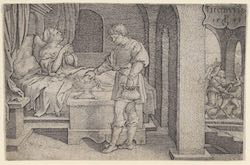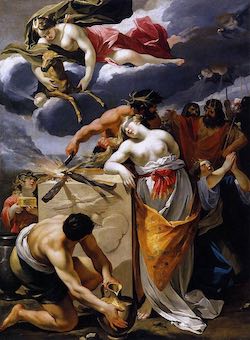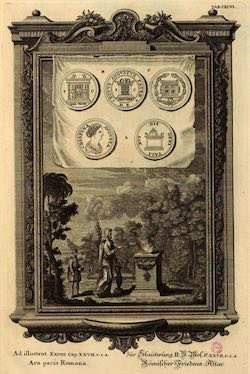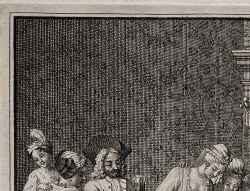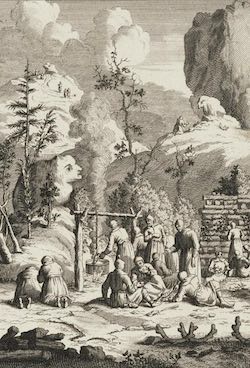Topic: 2. Sacrifice and religion: Comparisons, Antiquarians, Anthropology (16th-18th Century)
Religious sacrifices across various cultures and contexts sparked widespread interest in Early Modern Europe. As Christianity expanded into regions inhabited by "infidels" and "pagans", Europeans encountered a diverse array of sacrificial customs, ranging from the Sati rituals in India to the Aztec sacrifices in the Americas. This cross-cultural exposure captivated a wide audience, including theologians, philosophers, political thinkers, antiquarians, orientalists, missionaries, poets, artists, and even the general public. These encounters broadened the European understanding of sacrifice and led to a critical reassessment of classical and biblical sacrificial rites. This section includes:
- Sources: A selection of early modern printed materials, which include descriptions of the Americas, Asia, and Africa, alongside antiquarian and philological studies on religious sacrifice in classical antiquity and beyond. It also presents early modern works of ethnological observations and the first attempts to compare different sacrificial practices in various traditions and contexts, laying the groundwork for disciplines like the history of religions and anthropology.
- Iconographic Representations: A rich collection of images from the 16th to 18th centuries, illustrating a range of sacrificial rituals and practices as seen in different cultural and geographical contexts.
- Related Bibliography: An extensive bibliography spanning scholarly works from the 19th to 21st centuries, providing contemporary analyses and interpretations of these early studies and observations.
Seeing a global Islam? Eid al-Adha on Instagram
in: Cyber Muslims: mapping Islamic digital media in the internet age, pp. 176-178
: , 2022.
Philosophia secreta: donde debaxo de historias fabulosas se contiene mucha doctrina prouechosa a todos estudios: con el origen de los idolos, o Dioses de la gentilidad
Çaragoça: Miguel Fortuño Sanchez, 1599.
Il Simonino. Geografia di un culto.Con saggi di Diego Quaglioni e Laura Dal Prà
Trento: Società di Studi Trentini di Scienze Storiche, 2012.
Il sacrificio di Ifigenia [1632 - 1633]
Musée des Beaux-Arts, Dijon
I corpi sacrificali: smembramento e rimembramento. I presupposti culturali di Rom 12, 1-2
in: Atti del VII simposio di Tarso su S. Paolo Apostolo, pp. 437-468
Rome: Pontificio Ateneo Antoniano. Istituto Francescano di Spiritualità, 2002.
Isaac, Iphigenia, Ignatius. Martyrdom and Humand Sacrifice
Budapest - New York: Central European University Press, 2017.
Animal Sacrifice in ancient Greek Religion, Judaism, and Christianity, 100 BC--AD 200
Oxford - New York : Oxford University Press, 2008.
Exodi, Cap. XXVII, v. 1-8, Ara Holocausti prospectus alius (1732 - 1737)
from: J. J. Scheuchzer, Physique sacrée, ou Histoire naturelle de la Bible, Amsterdam, Pierre Schenk - Pierre Mortier, 1732 - 1737, tome second, tab. CXCIV
Exodi, Cap. XXVII, v. 1-8, Ara pacis Romana (1732 - 1737)
from: J. J. Scheuchzer, Physique sacrée, ou Histoire naturelle de la Bible, Amsterdam, Pierre Schenk - Pierre Mortier, 1732 - 1737, tome second, tab. CXCVI
Gen. Cap. XXII, v. 10-13, Aquila liberat Helenam sacrificio (1732 - 1737)
from: J. J. Scheuchzer, Physique sacrée, ou Histoire naturelle de la Bible, Amsterdam, Pierre Schenk - Pierre Mortier, 1732 - 1737, tome premier, tab. LXXXIII
Genesis, Cap. XXII, v. 13, Abrahamus sacrificans (1732 - 1737)
from: J. J. Scheuchzer, Physique sacrée, ou Histoire naturelle de la Bible, Amsterdam, Pierre Schenk - Pierre Mortier, 1732 - 1737, tome premier, tab. LXXXIII
A Portugese Jewish circumcision ceremony (1714)
from: Picart, Cérémonies et coutumes religieuses de tous les peuples du monde
Wellcome Collection, London
Ancient Nordic Sami People Sacrifice and Pagan Religious Feast (1723 - 1743)
from: Picart, Bernard; Bernard, Jean Frederic. Religious Ceremonies and Customs of All the Peoples of the World, 1723-1743
Le grand sacrifice des Canadiens à Quitchi-Manitou ou le Grand Esprit (1723)
from: Picart, Bernard. Cérémonies et coutumes religieuses de tous les peuples du monde: représentées par des figures, deel III. Amsterdam: Jean Frédéric Bernard, 1723-1743
Rijksmuseum, Amsterdam

